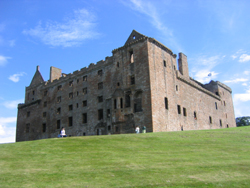The First 'Battle' of Linlithgow

According to Douglas writing to Thomas Magnus the English ambassador, Hamilton was able to muster in the region of 5,000 men from the local estates around Linlithgow at the ‘wappinschaw’ including Lords Eglington, Cassilis, Sympill, Avondale, Ross and Hume and the Abbot of Jedworth and the Laird of Ferniehurst. They pitched camp around the Peel and awaited the arrival of the Queen’s contingent. Angus seized the initiative, placed the King at the head of the Edinburgh militia and along with Lennox, Argyll and some 7,000 troops, marched on the rebels on the 16th January. Arran had made no effort to construct a defensive position and with the royal banner approaching, he was easily dissuaded by the Lord Chancellor Beaton and the Bishop of Aberdeen, from taking up arms against the King on his own. His army returned to their houses and Arran fled. Douglas notes with some irony:
‘war warnyt of oure cummyng and incontinent there ffir dislugit thareself, fled and left the toune, quhare we logit that nycht.
Arran met with Moray, the Bishop of Ross and Queen Margaret on the road to Stirling with ‘sundrie uther northern men’. The Queen joined him in the flight to Hamilton whereas Moray rode on to Linlithgow and met with Douglas a mile out of town probably at the bridge. Realising all was lost Moray promptly threw in his lot with the Douglases, claiming he had been deceived by the Queen into believing the King was in need of rescue. The Douglases spent the night at Linlithgow Palace partying , safe in the knowledge that any man who bore arms against him was doing so against his King.
Angus was in complete mastery of the crown. When Beaton was asked by the King in another one of those ‘letters’ to hand over the Great Seal, he sent it, not to the King, but straight to Angus. This was a blatant acknowledgement by Beaton of where the real power now lay.
By March however the pressure was building on Douglas. On the 18th he wrote to Magnus again excusing himself from attending a Peace Day with Earl of Westmoreland because:
‘ Will not leave the King for danger’ and ‘all my lords have left except Glasgow and Lennox’
Magnus replied stating that they, the English, would look towards Angus, Argyle and Lennox should Albany return to Scotland. However Magnus held some reservations of his own, writing to Wolseley on the 20th that the council had been :
‘overshot for feigned reasons’
In the meantime Margaret did her fading cause no good at all when in March she married Henry Stewart. This time her marriage was more for pleasure than for political gain but it so angered Arran that he defected to the Douglas cause taking with him many of his supporters that had gathered at Linlithgow that winter.
Angus went on to try to secure his power by having parliament declare in June 1526 that the King had officially reached his ‘majority’ and should take on full powers of his kingship. This cancelled out all other power sharing agreements and placed the King on the throne with Angus as his right hand man. From henceforth any attack on Angus would be seen as an attack on the King and an act of treason punishable by death. Angus then flooded the royal household with his family members often creating meaningless positions to do so. It meant that Douglas’s men surrounded the King, day and night. Now more than ever James felt a prisoner to his stepfather.
Angus however had unwittingly sowed the seeds for his own downfall. James embraced his newfound authority and was in a position to take more risks. In June, a secret committee was set up within parliament to assist the king. Again Angus was among the instigators but amongst the members was the Earl of Lennox, uncle to the King and a firm friend. Lennox was young, dashing and well admired by the court. He to had lost his father at Flodden. Yet he was no supporter of lost causes, refusing to support Albany in his reckless excursions into England and had already ridden in support of Douglas on his return. Now he was to be called upon to support his King. In an extraordinary act of independence, James chose Lennox ‘fyrst and befor ony man’ to be his advisor. This was a blatant rebuff of the Angus’s domination. Lennox could not be considered an innocent bystander in these affairs, as his family were the next in line to the throne after the Hamiltons and before the Douglases. Lennox was orchestrating his own coup over the Hamiltons and whether or not he had a say in the king’s pledge, he was more than happy to take on the role. Certainly his support of Douglas in the first bloodless confrontation at Linlithgow was in line with the Lennox strategy to usurp the Hamiltons.
Likewise, Angus’s apparent unconditional acceptance of Arran despite the treasonable act at Linlithgow had left Lennox with no alternative but to swap allegiance to the Queen and he took with him Glencairn and the Earl of Cassillis. Lennox’s first promise to his new ally was to plot for the King’s safe return or die in the attempt.
Lennox got his first opportunity to fulfil his promise in July 1526. The pressure on Angus to address the mounting unlawfulness in the borders was growing since he had failed to attend the previous Peace days. The Armstrongs had mounted recent raids into England using the Nixon properties as safe houses. The council of Scotland wrote to the Earl of Cumberland acknowledging receipt of his complaints and reiterating their intention to destroy all the thieves. The letter ends by declaring that King James will leave Edinburgh on the 17th July for the Borders with the intent of punishing the thieves.

